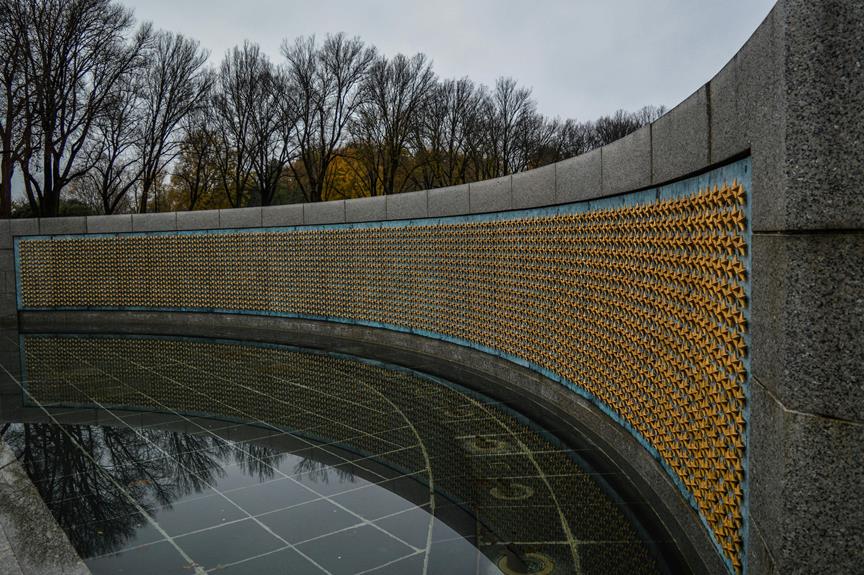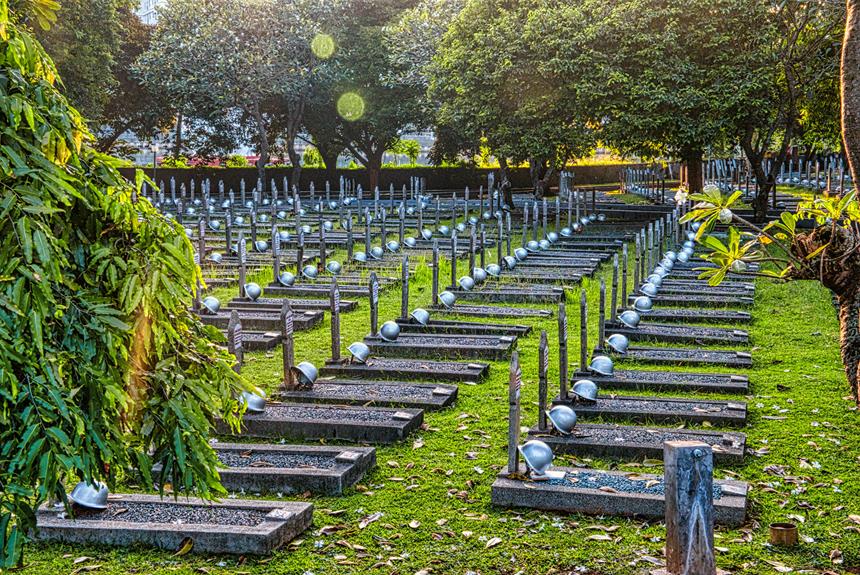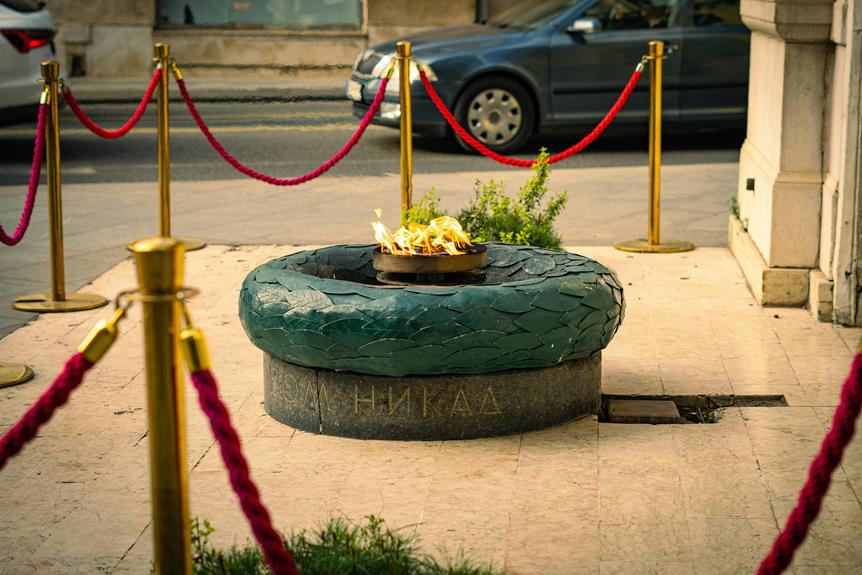The Vukovar Memorial in Croatia stands as a solemn symbol to the country's tumultuous past, embodying resilience and remembrance. Its stark architectural design and historical significance draw visitors from around the world to reflect on the sacrifices made during the Croatian War of Independence. However, beyond its physical attributes, the memorial also holds a deeper narrative that resonates with those who seek to understand the complexities of conflict and the resilience of the human spirit. This memorial serves as a powerful touchstone for collective memory and a catalyst for broader conversations about peace, reconciliation, and the enduring legacy of war.
Key Takeaways
- Established in 1997 to commemorate the Croatian War of Independence.
- Designed by sculptor Dusan Dzamonja, featuring a 30-meter tall concrete cross.
- Hosts annual Remembrance Day ceremony on November 18th.
- Encourages respectful behavior and modest dress from visitors.
- Symbol of remembrance, promoting social healing and understanding in society.
History of the Vukovar Memorial
Having been established in 1997, the Vukovar Memorial in Croatia serves as a poignant reminder of the devastating events that transpired during the Croatian War of Independence. The construction details of the memorial reflect a deep respect for the history it symbolizes. Situated on the outskirts of Vukovar, the memorial was designed by sculptor Dusan Dzamonja, known for his powerful and emotive works. The central feature of the memorial is a striking 30-meter tall concrete cross that stands as a symbol of remembrance and resilience.
The cultural significance of the Vukovar Memorial cannot be overstated. It stands as a tribute to the victims of the war and a confirmation to the strength of the human spirit in the face of adversity. The memorial site includes a museum that houses artifacts and exhibits related to the war, providing visitors with a detailed understanding of the events that unfolded in Vukovar.
The construction of the memorial was a collaborative effort, with contributions from artists, architects, and local communities. The stark and minimalist design of the memorial serves to emphasize the gravity of the events it commemorates. Each element of the memorial, from the towering cross to the surrounding landscape, has been carefully curated to create a space for reflection and contemplation. The Vukovar Memorial stands as a somber yet powerful reminder of the importance of preserving memory and honoring the past.
Architectural Features of the Memorial
The architectural features of the Vukovar Memorial in Croatia exhibit a blend of symbolic significance and artistic expression, reflecting a profound tribute to the victims of the Croatian War of Independence. The memorial's design encapsulates concrete symbolism through its structure and layout. One of the prominent features is the towering concrete cross at the entrance, symbolizing sacrifice and remembrance. The cross serves as a focal point, drawing visitors into a reflective space that honors the memory of those who lost their lives during the war.
Artistic expression is evident throughout the memorial, with intricate details and thoughtful design elements enhancing its emotional impact. The use of stark concrete juxtaposed with delicate engravings creates a sense of contrast, symbolizing the resilience and fragility of life. The architectural layout, including winding pathways and secluded alcoves, encourages contemplation and introspection, inviting visitors to engage with the memorial on a personal level.
Moreover, the integration of natural elements such as trees and water features adds a sense of tranquility to the space, fostering a serene atmosphere for reflection and remembrance. The overall design of the Vukovar Memorial harmoniously combines concrete symbolism with artistic expression, creating a powerful and poignant tribute to the victims of the Croatian War of Independence.
Commemorative Events and Ceremonies
Signifying the enduring reverence for the fallen and the solemn remembrance of their sacrifices, the Vukovar Memorial in Croatia hosts a series of commemorative events and ceremonies. These events play an important role in honoring the memory of those who lost their lives during the Battle of Vukovar and hold immense cultural significance for the local community.
Throughout the year, the memorial site becomes a focal point for various commemorations deeply rooted in local traditions. One such event is the annual Remembrance Day ceremony held on November 18th, marking the day when Vukovar fell in 1991. During this solemn occasion, locals, dignitaries, and visitors gather to pay their respects, lay wreaths, and observe a minute of silence in honor of the fallen.
In addition to the Remembrance Day ceremony, the memorial hosts other events that highlight the resilience and unity of the Croatian people. These ceremonies often include religious services, patriotic songs, and symbolic gestures that serve to remind future generations of the sacrifices made for freedom and independence.
The commemorative events at the Vukovar Memorial not only provide a platform for collective mourning but also serve as a reminder of the enduring spirit of the Croatian people. By preserving local traditions and cultural practices, these ceremonies make sure that the sacrifices made in Vukovar will never be forgotten.
Visitor Information and Guidelines
Located in Croatia, the Vukovar Memorial provides essential visitor information and guidelines for those wishing to pay their respects and learn more about the historical significance of the site. The memorial offers a profound visitor experience by allowing individuals to explore the cultural significance of the location.
Visitors to the Vukovar Memorial are encouraged to approach the site with respect and solemnity. It is advised to dress modestly and behave in a manner that reflects the gravity of the memorial's purpose. Photography is permitted, but visitors are requested to do so discreetly and refrain from taking selfies or engaging in any behavior that may be deemed disrespectful.
Guided tours are available for those who wish to investigate further into the history and context of the memorial. These tours provide valuable insights into the events that transpired in Vukovar and the impact they had on the local community and the broader Croatian society.
To enhance the visitor experience, the memorial has informational plaques and exhibits that offer detailed accounts of the historical events that unfolded in Vukovar. Additionally, there are designated areas for quiet reflection and contemplation, allowing visitors to pay their respects in a tranquil setting. By following these guidelines and immersing oneself in the cultural significance of the memorial, visitors can gain a deeper understanding of the importance of preserving the memory of Vukovar.
Impact of the Memorial on Society
The Vukovar Memorial has had a profound impact on Croatian society, shaping collective memory and fostering reflection on the nation's historical turmoil. This commemorative site stands as a symbol of remembrance for the victims of the 1991 siege of Vukovar during the Croatian War of Independence. The memorial's significance extends beyond its physical presence; it serves as a place of social healing, where individuals can pay homage to the past while contemplating the implications of war and conflict in contemporary society.
The memorial's role in fostering social healing is evident in the way it brings people together to honor the memory of those who lost their lives in the conflict. By providing a space for collective mourning and reflection, the memorial encourages dialogue and understanding among different segments of society, ultimately contributing to the reconciliation process. Moreover, the cultural significance of the Vukovar Memorial lies in its ability to preserve and transmit historical narratives to future generations, ensuring that the lessons learned from the past are not forgotten.
Frequently Asked Questions
What Is the Significance of the Materials Used in the Memorial's Construction?
The significance of materials used in a memorial's construction lies in their ability to convey symbolism and support the architectural design.
Materials such as concrete, steel, and glass can be chosen for their durability, aesthetic appeal, and ability to evoke specific emotions or themes.
The careful selection and integration of materials contribute to the overall message and impact of the memorial, enhancing its ability to resonate with visitors and convey its intended meaning.
How Does the Memorial Preserve the Memory of the Victims?
Preserving the memory of victims is a solemn duty that transcends time and place. Honoring those lost through tragedies guarantees their stories are not forgotten.
Are There Any Specific Rituals or Customs Associated With the Memorial?
In many memorials worldwide, specific rituals, customs, and commemoration ceremonies play an essential role in preserving the memory of victims. These practices are often deeply rooted in cultural traditions and serve as a way to engage the community in remembering and honoring those who suffered.
Educational programs are also commonly integrated to provide historical context and promote understanding. Such initiatives contribute to the continued significance of memorials and the lessons they impart.
Can Visitors Participate in Any Interactive Experiences at the Memorial?
Visitors to the memorial can engage in a variety of interactive experiences. Interactive exhibits offer a hands-on approach to learning about the historical significance of the site.
Educational workshops provide visitors with a deeper understanding of the events that transpired. These experiences allow participants to actively engage with the material, fostering a more immersive and meaningful connection to the memorial's purpose.
How Has the Memorial Influenced the Local Community's Perspectives on History?
The memorial has deeply impacted local perspectives on history by serving as a poignant reminder of past events. Its presence in the community has sparked discussions, promoted remembrance, and fostered a deeper understanding of the region's complex historical narrative.
Through educational programs and commemorative events, the memorial has actively engaged the local community in reflecting on the impact of historical events and their lasting effects on society.
Conclusion
In culmination, the Vukovar Memorial in Croatia stands as a somber testimony to the sacrifices and struggles endured during the Croatian War of Independence. Its towering concrete cross and museum serve as poignant symbols of remembrance and reflection.
Through its annual ceremonies and ongoing impact on society, the memorial fosters healing and understanding, preserving the memory of the war's victims for future generations to honor and learn from.


